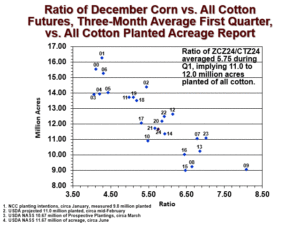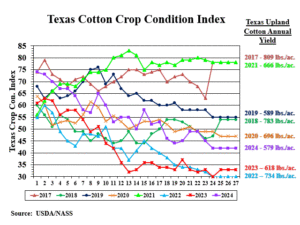Policy Uncertainty. Policy changes are a common source of surprises (“shocks”) to cotton market outcomes. Recent years provide numerous case studies. Some examples include India’s domestic minimum support price program, the U.S. 2018 farm bill, the U.S.-China Phase One Agreement, the U.S. Market Facilitation Program, the U.S. CARES Act, U.S. trade sanctions on products from Xinjiang Province, and the periodic policy announcements of the Chinese National Development and Reform Commission, which include management of their cotton reserves, and cotton import quota announcements. The most anticipated policy events on the horizon are near term disaster aid and/or economic aid, with the (presumably 2025) Farm Bill being delayed until the middle of next year. The unexpected string of tariffs and counter-tariffs are the most recent example of policy shocks. The retaliatory tariffs by China on U.S. cotton should have minor impact because of the relatively small volume of U.S. cotton sold to China this year. However, the impact of the unexpected tariff announcements is increasing general uncertainty which can have a wet blanket effect on the cotton futures market.
Supply Uncertainty.
The cotton market continues to wrestle with the question of the size of the 2024 U.S. cotton crop. The first question is how much acreage has been planted. The price of competing crops, relative to cotton prices, is an important consideration to the level of planted acreage. The chart below shows a fairly strong relationship between the level of U.S. upland and pima cotton planted, as measured on June 30, and the ratio of December CBOT corn futures and ICE cotton futures during the first quarter of the year. The higher the ratio, the less cotton is planted. Of course, there are other important competing crops as well: sorghum, soybeans, peanuts, and perhaps wheat. And there are other non-price influences, including how dry it was in Texas, the insurance base price, fixed cost influences, and the psychological influence of the preceding growing season. But the price ratio of corn to cotton appears to capture a lot of these other influences in explaining variations in cotton plantings.
Demand Uncertainty. For U.S. cotton, the two main demand categories are domestic mill use and exports. Domestic U.S. consumption is forecasted by USDA a little over two million bales. Exports are generally a more important source of demand as they represent over 80% of U.S. cotton use. The main indicators of export demand are weekly sales and shipments of U.S. cotton. For the weeks in late January and early February, net sales of U.S. cotton picked up, which would have been expected given how cheaply U.S. cotton is priced. However, this decent streak of sales ended in mid-March with the most recent (July 3) old crop export sales numbers continuing to disappoint. However, I would interpret unspectacular weekly export sales differently depending on the season. In the middle of the marketing year, I see it as an indicator of weak demand. Where we are now at the end of the old crop marketing year, unspectacular export sales is more of a supply issue, i.e. there isn’t much old crop cotton around left to sell.
Another wrinkle to the global supply questions, and hence the specific demand for U.S. exports, is how are main competitors are doing. Brazil and Australia are our main competitors, and they have having very good crops in recent years.
Lastly, there is the question of longer term demand. I am cautious about the possibility of macro headwinds related to world GDP, inflation, and central bank policy. Stagflation is a possible risk that is historically associated with declining cotton demand. Short of that, just having low, slow growth in the world economy could deprive the cotton market of sustained price support, leaving only the volatile and short lived weather market influence discussed above.

